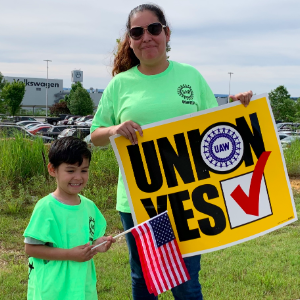States with right-to-work laws could foil Democratic efforts to take the White House in 2020, depending on who wins their party’s nomination for president.
According to a study from the National Bureau of Economic Research (NBER), Democratic voter turnout is much lower in states with right-to-work laws due to financially weakened unions, which usually support and contribute to Democratic campaigns.
Data from the Cooperative Congressional Election Study also found that in 2016, more union members voted for Donald Trump than for Democrats.
A Wall Street Journal story featuring union members in the Rust Belt (which refers to former industrial hubs in Midatlantic and Midwest states like Indiana, Illinois, Ohio, Pennsylvania and Wisconsin) reported that even though many of them had voted for Democrats throughout their lives, they voted for Trump in 2016.
Given the recent Janus v. AFSCME decision, Democrat-friendly unions are in a tight spot with regard to painting the White House blue in 2020.
Labor experts and political pundits insist swing states and working-class dominant states voted for Trump because he listened to them and spoke their language. Trump promised change for the rural communities left behind by globalization amid the prosperity of the East and West Coasts.
If Democrats want to win in 2020, said Thomas Kochan, co-director of the MIT Sloan Institute for Work and Employment Research, then the Democratic nominee needs to listen to and respect blue-collar workers.
“One of the primary reasons [Trump won] is the Clinton campaign took too many of those voters for granted,” Kochan told InsideSources. “In states like Wisconsin and Michigan in particular. It was clear that a lot of people in those states felt disrespected and abandoned by the Democratic Party. And that mistake is not going to be made again — you’re going to see whoever is the Democratic candidate canvassing in those states and listening to the people. I suspect there will be a concentrated effort not to make the same mistake. Whether that’s enough to win back those voters remains to be seen.”
Kochan confirmed the results of the NBER study, saying unions definitely don’t have as much political influence as they used to because of right-to-work laws.
“That will play a role in 2020 politics, no question,” he said, “but there’s a lot of recognition within the labor groups that new steps need to be taken to address this, and we see this all over the country. So I think there will be much more discussion of labor and political issues in the 2020 election and elevate the voter sensitivity around these issues.”
In other words, collecting blue-collar and working-class votes will be more important than ever in 2020.
Due to the weakened state of many private-sector unions, new labor rights groups are rising up to fill the gap, like Fight for 15 and Working America.
“The most successful has been the Fight for 15, [which is] supported by and funded by labor unions, but it is also a grassroots effort with a lot of community groups, immigrant groups, community centers,” Kochan said. “We also see immigrant groups getting immigrants registered to vote. You see African-American groups becoming more active in getting their constituents registered and activated to overcome what happened in some key states like Wisconsin when minorities voted less frequently than they had in the past. [Working America] is accelerating their efforts to canvas people on issues.”
But those efforts won’t mean much if the Democratic nominee doesn’t listen to workers. Many union members in industrial sectors already plan to vote for Trump again.
“It is clear that many working families are very frustrated and don’t think either party has paid attention to their concerns, so whoever can produce a more trusted set of ideas and candidates will get their support, but that will be up for grabs,” Kochan said.
Even though Sen. Elizabeth Warren (D-Mass.) is currently the frontrunner, Sen. Bernie Sanders (I-Vt.) is well-known for his focus on listening to and developing policies for the working class and blue-collar sectors. His campaign trail closely follows the trail of blue-collar cities and municipalities along the Rust Belt.
According to data from the Center for Responsive Politics, Sanders gets the most funding from working-class Americans out of all the Democratic candidates, almost $30 million more than the candidate with the second place spot: Warren.
Before Trump, the last Democratic or Republican nominee to really listen to and capture the votes of working-class Americans was Bill Clinton in 1992, Kochan said.
“John F. Kennedy came through Wisconsin and really changed the minds of many voters, including in my family, they said, this guy is really credible and understands what we’re experiencing here, and he was able to defeat Humphrey who was a neighbor in Minnesota because [Kennedy] brought fresh ideas and listened,” Kochan said. “And then Ronald Reagan in 1980, he had a very straightforward question, are you better off today than you were four years ago? And they said, no we’re not. And then Bill Clinton in 1992, it [was all about] jobs. It was those straightforward and clear messages that were credible and resonated enough with the voters to say, this is what we’re experiencing and these candidates seem to get it. And we haven’t seen that since.”

